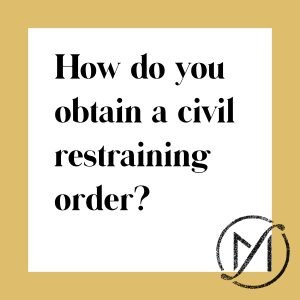How Do You Obtain a Civil Restraining Order?

There are three main types of restraining orders in Connecticut — also referred to as “protective orders.” The protective order that occurs in Family Court is called a Civil Restraining Order. Please read on to learn more about how to obtain a Civil Restraining Order from the Connecticut Family Court.
Background on Protective Orders
There are three types of restraining orders or protective orders in Connecticut: (1) Civil Restraining Orders (“Relief From Abuse”), (2) Civil Protective Orders, and (3) Criminal Protective Orders.
Civil Restraining Orders and Civil Protective Orders take place in civil courts (the Family Court and the Superior Court, respectively). This means that a judge can issue either regardless of whether the police arrested the accused person (“respondent”).
Read: What are the Types of Restraining Orders?
Civil Restraining Orders (“Relief From Abuse”)
A Civil Restraining Order provides relief from physical abuse, stalking, or a pattern of threatening from a family or household member. A Civil Restraining Order takes place in a Connecticut Family Court, which is a civil court. This means that a judge can issue a Civil Restraining Order regardless of whether police arrested the respondent.
Who is Eligible For a Civil Restraining Order?
Any family or household member subjected to a continuous threat of physical pain or physical injury, stalking, or a pattern of threatening may apply to the Superior Court for a restraining order. “Family or household members” are any of the following:
- Spouses or persons who have a civil union
- Former spouses or persons who a civil union
- People related by blood or marriage
- Those not related by blood or marriage living together as intimate partners (cohabitating)
- People not related by blood or marriage who formerly cohabitated as intimate partners
- Those who have a child in common, regardless of whether they have been married or cohabitated
- People who have (or recently had) a dating relationship
How Do You Obtain a Restraining Order?
To obtain a restraining order, the petitioner (or his or her attorney) files an application and affidavit with the court stating the condition from which relief is sought. The applicant may indicate whether the respondent is permitted to carry a pistol or revolver or possesses firearms or ammunition.
The court may issue an order without notice or hearing to the respondent if it finds that there is an immediate and present physical danger to the applicant. We refer to this as an “ex parte.” Even when the court issues an ex parte order, it must hold a hearing on the application within 14 days of receiving the application. The court gives the alleged offender at least 5 days notice before the hearing. Filing for a Restraining Order does not preclude the applicant from subsequently seeking any other civil or criminal relief based on the same facts and circumstances.
Read: What Can the Court Order in a Civil Restraining Order?
Next Steps
Unsure how a Civil Restraining Order might work in your case? We are happy to assist. Freed Marcroft’s first step, the Goals & Planning Conference is designed to get to the heart of your problem and unveil your true goals for your life. Once we discover your goals, we take all of our collective experience in the realm of divorce to build a customized strategy for you. Schedule your Goals & Planning Conference today, or contact us here.








